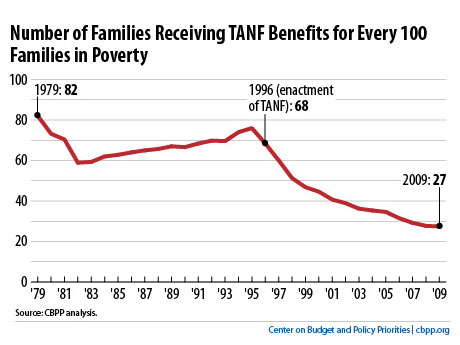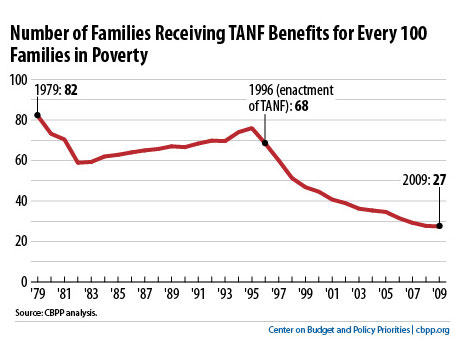
On this day 15 years ago, President Bill Clinton signed a sweeping overhaul of the nation’s welfare system that enacted onerous work requirements on poor families before they could collect government aid. The new law fulfilled Republicans long-held desire to (in the words of President Clinton) “end welfare as we know it” by creating the Temporary Assistance for Needy Families (TANF) “block grant” program.
The reform achieved its goal of reducing the number of families receiving federal aid: in the process, it also shredded America’s ability to help its neediest families during an economic downturn. The nonpartisan Center on Budget and Policy Priorities has released a series of charts illustrating that TANF has failed to keep pace with the needs of struggling American families, especially during this long and difficult recession:

The number of low-income families receiving welfare has fallen from 68 percent in 1996 to 27 percent today. As the American Prospect’s Jake Blumgart noted, unlike the old system, which could respond to greater need when the economy went south, the TANF block grant program “provides an annual lump sum of $16.6 billion, with no allotted increases for recession, population growth, or rises in the cost of living.” It has even failed to keep up with inflation. In short, TANF’s ability to provide income support to those who need it most has declined dramatically.
Thus, during the worst recession in 80 years, TANF only reached 4.5 million families, or less than a third of those living in poverty. “By contrast, in 1995, the old welfare system covered 13.5 million families, or 75 percent of those living in poverty,” Blumgart wrote. The food stamp program — which does not face the same limitations as TANF — increased by 57 percent in 2009, in response to growing demand driven by high joblessness. As the CBPP’s LaDonna Pavetti, vice president for family income support, observed, “in the process of trying to impose very stringent work requirements, we’ve lost the program’s ability to provide a safety net for the people who are unable to find work.”
Help us Prepare for Trump’s Day One
Trump is busy getting ready for Day One of his presidency – but so is Truthout.
Trump has made it no secret that he is planning a demolition-style attack on both specific communities and democracy as a whole, beginning on his first day in office. With over 25 executive orders and directives queued up for January 20, he’s promised to “launch the largest deportation program in American history,” roll back anti-discrimination protections for transgender students, and implement a “drill, drill, drill” approach to ramp up oil and gas extraction.
Organizations like Truthout are also being threatened by legislation like HR 9495, the “nonprofit killer bill” that would allow the Treasury Secretary to declare any nonprofit a “terrorist-supporting organization” and strip its tax-exempt status without due process. Progressive media like Truthout that has courageously focused on reporting on Israel’s genocide in Gaza are in the bill’s crosshairs.
As journalists, we have a responsibility to look at hard realities and communicate them to you. We hope that you, like us, can use this information to prepare for what’s to come.
And if you feel uncertain about what to do in the face of a second Trump administration, we invite you to be an indispensable part of Truthout’s preparations.
In addition to covering the widespread onslaught of draconian policy, we’re shoring up our resources for what might come next for progressive media: bad-faith lawsuits from far-right ghouls, legislation that seeks to strip us of our ability to receive tax-deductible donations, and further throttling of our reach on social media platforms owned by Trump’s sycophants.
We’re preparing right now for Trump’s Day One: building a brave coalition of movement media; reaching out to the activists, academics, and thinkers we trust to shine a light on the inner workings of authoritarianism; and planning to use journalism as a tool to equip movements to protect the people, lands, and principles most vulnerable to Trump’s destruction.
We urgently need your help to prepare. As you know, our December fundraiser is our most important of the year and will determine the scale of work we’ll be able to do in 2025. We’ve set two goals: to raise $81,000 in one-time donations and to add 1250 new monthly donors by midnight on December 31.
Today, we’re asking all of our readers to start a monthly donation or make a one-time donation – as a commitment to stand with us on day one of Trump’s presidency, and every day after that, as we produce journalism that combats authoritarianism, censorship, injustice, and misinformation. You’re an essential part of our future – please join the movement by making a tax-deductible donation today.
If you have the means to make a substantial gift, please dig deep during this critical time!
With gratitude and resolve,
Maya, Negin, Saima, and Ziggy